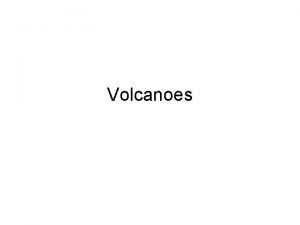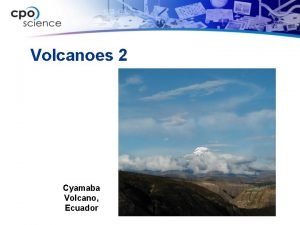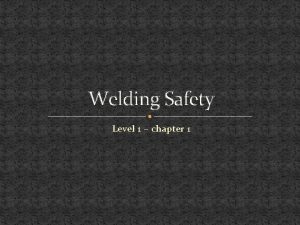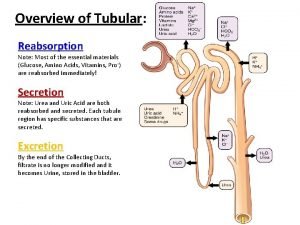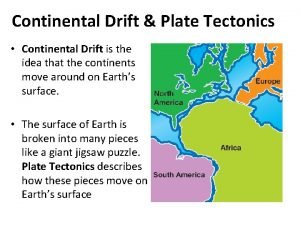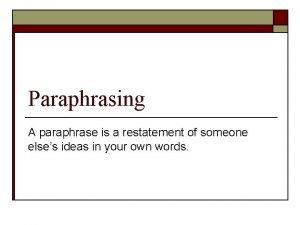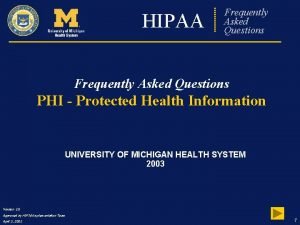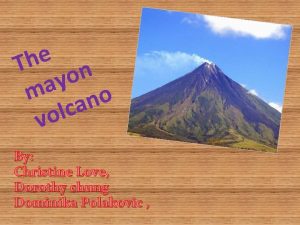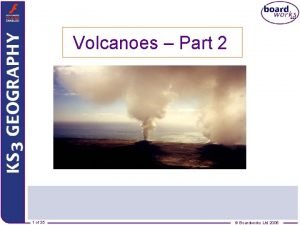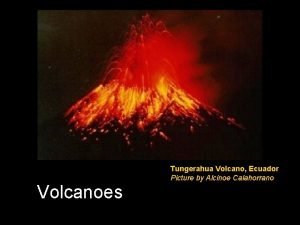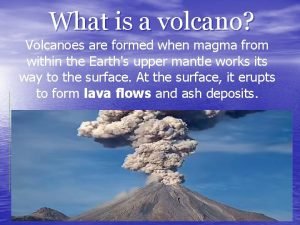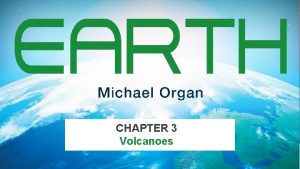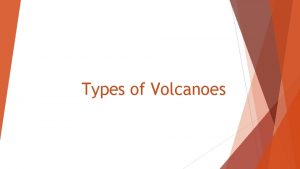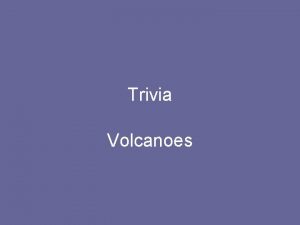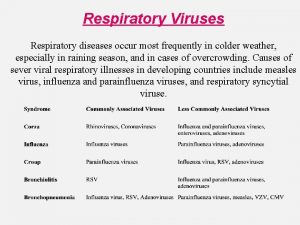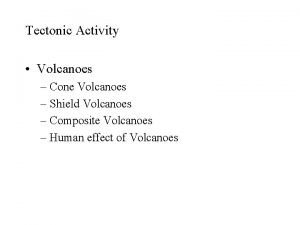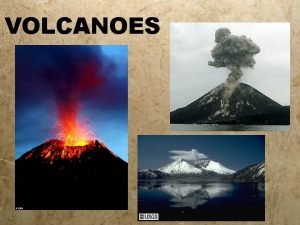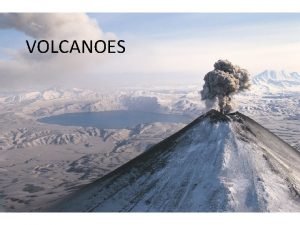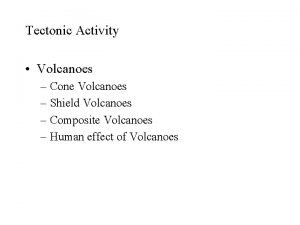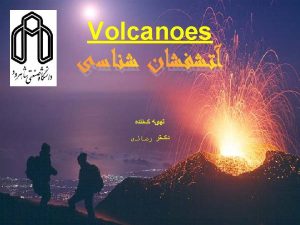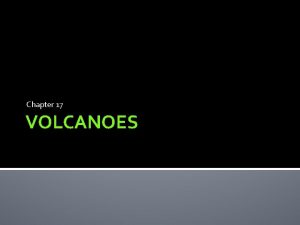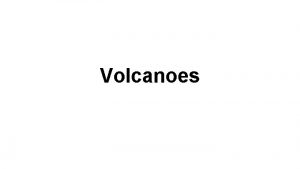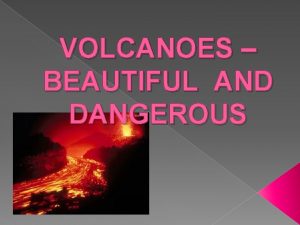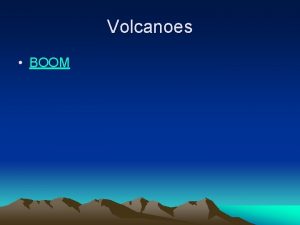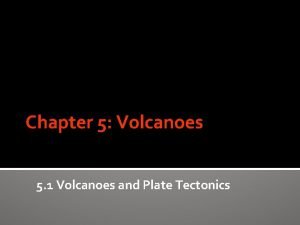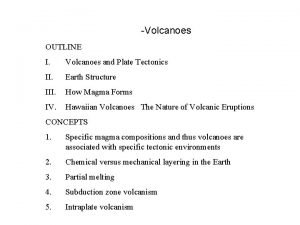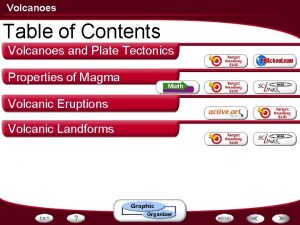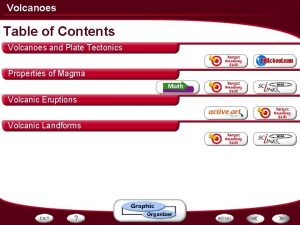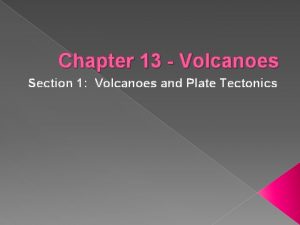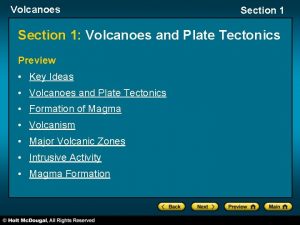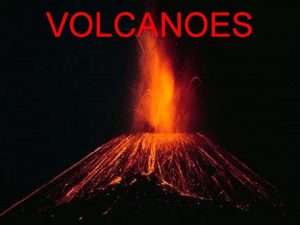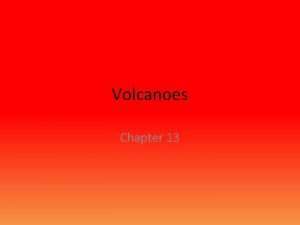Volcanoes Where Volcanoes occur most frequently at plate
























- Slides: 24

Volcanoes

Where? Volcanoes occur most frequently at plate boundaries. Some volcanoes, like those that form the Hawaiian Islands, occur in the interior of plates at areas called hot spots. The greatest number of volcanoes occur on the ocean floor along spreading ridges. Over 80% of those on land occur at edges of continents, or subduction zones, where one plate subducts under another plate.

Ring of fire

Why? Temperatures in the mantle are hot enough to melt rock into magma. Less dense than the solid rock around it, magma rises and some of it collects in magma chambers. As the magma rises, pressure decreases allowing trapped gasses to expand propel the magma through openings in the Earth’s surface causing an eruption. Erupted magma is called lava.

How does it work? Eruptions are described as explosive or effusive (loosely flowing). How explosive an eruption is depends on the magma’s chemical composition and gas content, which affect the magma’s stickiness, or viscosity. If magma is fluid, gases can escape rapidly and lava flows; if magma is viscous the gases can not escape and pressure builds inside the magma until the gases escape, sometimes violently.

What is lava? Magma is molten rock beneath the surface. Lava is erupted magma. There are 2 types of lava: A a (ah ah) is largely solidified rock that gets pushed forward. Pahoe (pahhoyhoy) is flowing “liquid” with a smooth, billowy surface

Types of lava flows Lava flows are superheated streams of molten rock that flow at 1 – 50 mph. Pyroclastic flows are avalanches of hot ash, rock fragments, and gases that flow at speeds greater than 100 mph. Landslides are avalanches of rock, snow and ice on slopes of volcanoes (loosened and tumbling due to seismic activity). Lahars (mud flows) are a mixture of volcanic ash and water (like wet concrete)

Vocab. A vent is an opening through which eruptions take place. A crater is a basin like depression over a vent, at the summit of a volcano A caldera is a depression larger than the original crater (>1 km. Diameter) that forms when the summit is blown off, or when the volcano collapses into the empty magma chamber. – Example : Crater Lake atop Mt. St. Helens.

Types of Volcanoes Repeated eruptions build three basic types of volcanoes based on shape and composition. Cinder Cones Shield Volcanoes Stratovolcanoes

Shield Volcanoes Shield volcanoes are broad gently sloping volcanic mountains slowly formed by layer over layer of solidified lava. Shield volcanoes are formed by effusive eruptions of fluid lava. These can become very large as the low viscosity lava spreads widely and thickly. Examples: Kilauea, Hawaii and Mt. Etna, Italy

Shield Volcanoes

Cinder Cones Cinder cones are the smallest volcanoes (< 500’), formed by explosive eruptions of lava, ash, and gas blown violently into the air. The erupting material breaks apart into fragments called cinders that fall and accumulate around the vent. Cinder cones are temporary geologic features as they are easily eroded. They have short life spans as gas causing violent eruptions is quickly depleted. Example: Paricutin, Mexico

Cinder Cones

Stratovolcanoes are formed from both explosive and effusive eruptions. Broad bases get steeper toward the top. Form from explosive eruptions, followed by quiet lava flows. This makes layers of ash and rock that get covered by layers of lava. Formed over long spans of time. Dormant for periods of 100, 000+ yrs. followed by a few years of intense activity. Examples: Aconcagua, Andes (22, 825’) and Mt. St. Helens

Stratovolcanoes

Monitoring and Predicting Volcanic Activity Volcanic activity is monitored using several observations: Land deformation Ash clouds Tremors- measured by seismic data Volcanic Tremors (VT) Rockfall (RF)

Mount Pinatubo www. teachersdomain. org/assets/wgbh/ess 05_vid _pinatubo/ess 05_vid_pinatubo_56. mov http: //www. teachersdomain. org/assets/wgbh/ess 05_vid_lahar/ess 05_vid_lahar_56. mov Open in quicktime

Copy and answer the questions. Was the Mount Pinatubo eruption a non-explosive or explosive eruption? Based on your observations, what type of volcano is Mount Pinatubo? On what evidence do you base your answer? Over what type of plate boundary is this volcano located? Is this tectonic setting consistent with your answer to the first question? Because volcanologists were able to accurately predict the timing of this eruption, the lives of hundreds of people who evacuated the nearby area were probably saved. What evidence did the scientists observe that prompted them to call for an evacuation?

Hawaii http: //www. teachersdomain. org/assets/wgbh/ess 05_vid_hawaii/ess 05_vid_hawaii_56. mov Open in quicktime

Hawaii 1. Based on your observations of this video and previous videos you have seen, what type of volcanoes are Kilauea and the other Hawaiian volcanoes? On what evidence do you base your answer? 2. Does Hawai’i experience non-explosive or explosive eruptions? 3. Explain Hawaii’s setting in terms of plate boundaries. What makes it so unusual?

Mount St. Helens http: //www. sciencewithmrmilstid. com/media/ess 05_int_ helens. swf Click the link

Copy and Answer the Questions Describe what is happening throughout the eruption. What kind of material is being ejected by the volcano? Do you see lava? What happens to all of the ash? Based on your observations, what type of volcano produced this eruption? On what evidence do you base your answer? Based on the before and after images, identify ways in which both the volcano and surrounding area were changed by the 1980 eruption.

Copy and Answer the questions Based on the satellite images, how has the affected area changed in the time since the eruption? What are some similarities and differences in the destruction caused by effusive and explosive eruptions? What, if anything, was surprising to you about the blowdown, lahar, and pyroclastic flow images? What factors play a part in the recovery of vegetation (and wildlife) in areas affected by volcanic eruptions?

Sources http: //www. sciencewithmrmilstid. com/category/earthscience/volcanoes/
 Volcanic belts form along _____.
Volcanic belts form along _____. N
N Where is saltatory conduction most likely to occur
Where is saltatory conduction most likely to occur Most welding environment fires occur during
Most welding environment fires occur during Cephalocaudal and proximodistal pattern diagram
Cephalocaudal and proximodistal pattern diagram Water reabsorption in nephron
Water reabsorption in nephron Selective reabsorption in the proximal convoluted tubule
Selective reabsorption in the proximal convoluted tubule Pure culture
Pure culture Chapter 6 microbial nutrition and growth
Chapter 6 microbial nutrition and growth A denser oceanic plate collides with a continental plate
A denser oceanic plate collides with a continental plate Pour plate method steps
Pour plate method steps Converging continental plate and oceanic plate oreo
Converging continental plate and oceanic plate oreo How often answer
How often answer Florida technology integration matrix
Florida technology integration matrix Optimal page replacement algorithm calculator
Optimal page replacement algorithm calculator Restatement paraphrase
Restatement paraphrase Always, usually, often sometimes never
Always, usually, often sometimes never Repeated habitual actions
Repeated habitual actions Hipaa frequently asked questions
Hipaa frequently asked questions The crucible final test
The crucible final test Differentiate active and inactive volcanoes
Differentiate active and inactive volcanoes Types of volcanoes according to shape
Types of volcanoes according to shape Explain the theory of plate tectonics.
Explain the theory of plate tectonics. Active volcanoes map
Active volcanoes map How are volcanoes made
How are volcanoes made
